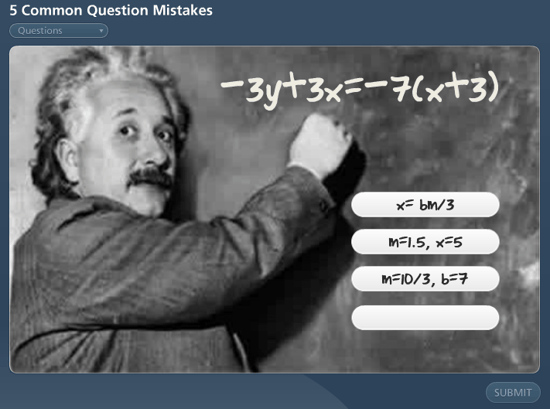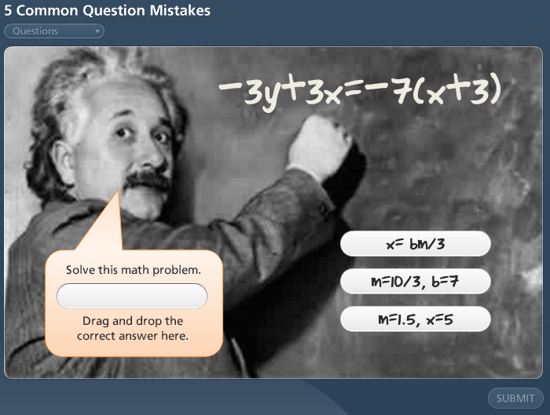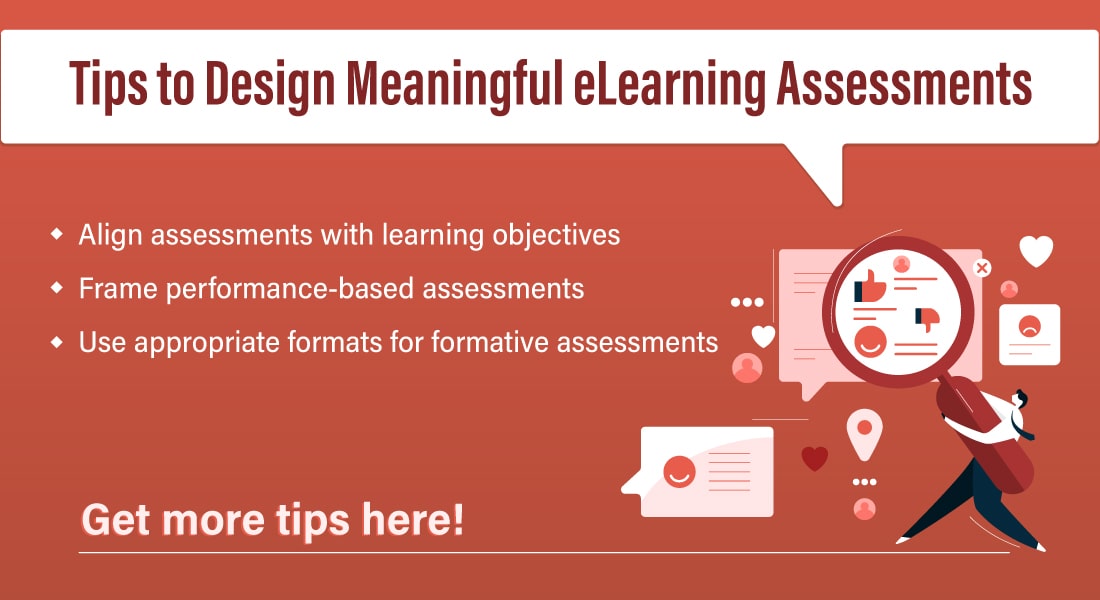6 Common Mistakes In eLearning Assessments to Avoid

The importance of eLearning assessments can’t be stressed enough – be it formative assessments used in the midst of the course (after the completion of each learning point), or summative assessments used at the end of a course to evaluate learners. eLearning assessments tell you if your learners understood and retained all the information from the course. They also aid in closing the learning cycle and reinforcing learning. Besides this, they let you know if the course itself was effective and helped meet your learners’ needs.
6 Common Mistakes to Avoid in eLearning Assessments
- Posing questions unaligned to learning objectives
- Using the same question format throughout
- Designing assessments in the last
- The learner is unaware how to answer the question
- Using slang and cultural references
- Scrimping on providing feedback
Yet, we find most organizations make quite a lot of mistakes, when designing eLearning assessments, which leads to an overall degradation in the learning experience.
6 Common eLearning Assessment Mistakes and How to Avoid Them
1. Posing Questions Unaligned with Learning Objectives in the Summative Assessment
The main purpose of a summative assessment is to evaluate whether the learning objectives of the course have been met. Yet we often come across questions in the summative assessment that are unaligned with the learning objectives of the course, leading to an ineffective evaluation.
Let us say the learning objective of an eLearning course is, “explain the steps to perform CPR effectively.”
Every year, more than _______ people in the United States have a stroke.
|
Is this question aligned to the learning objective? It might be related, but does it actually assess what the learners need to walk away with? No. Now, take a look at the next table.
Identify the correct sequence of performing CPR.
|
This question 2 is aligned with the learning objective and assesses learners on what they should walk away with, which will help them improve their performance on the job. This is how a question should be framed.
2. Designing eLearning Assessments after the Course
A major mistake most often made – designing eLearning assessments after creating the entire course content. You might be wondering why this is even wrong. After all, it is from the finalized content that we need to frame the questions, right? Well, no. Doing so might lead to not having enough time to design intellectually challenging assessments.
So, when should assessments be designed? Since assessments play an extremely vital role in a course, they need to be given adequate time for development. Hence, they should be designed immediately after identifying the learning objectives. In this way, the assessments will influence the design of the rest of the content and not vice versa, and it will be also ensure assessments are aligned with the learning objectives.
3. Using the Same Question Format Throughout
In an eLearning course, you often come across content presented in formats such as scenarios, games, simulations, videos, and GIFs. Yet, once the course moves on to the assessments, we tend to find the same old multiple choice questions, which tend to get boring and also encourage learners to ‘guess and check’, leading to an ineffective learning experience.
This should be avoided. Using the same question format throughout might end up making the learners extremely bored. Once you opt to deliver training through eLearning, you can incorporate and experiment with a wide range of assessment formats within your course. A few of these include:
Drag and Drop: The learner will have to drag and drop the right choice in a given space. For example, to test learners on a process, provide a drag and drop in which the learners will have to drag and drop the steps in the right sequence.
Rank Sequence: The learner will have to provide a sequence to the content provided by ranking them. For example, if you want your customer executive to understand the stages involved in a sales process, you can create a jumbled timeline of the process and ask them to rank in the correct order.
You can also deliver the assessments in a gamified format to ensure enhanced engagement:
- Crossword: The learner should type the answer in the boxes based on clues provided.
- Hangman: Based on the letters the learners choose to fill in the answer, the gallows stay stable or let go.
4. Providing Unclear Instructions on How to Attempt eLearning Assessments
Take a look at this assessment slide from a course.

Source:community.articulate.com
How are the learners supposed to answer the question? I spent nearly 5 minutes trying to figure what learners are expected to do, to answer the question. Eventually I realized learners should drag and drop the right answer into the 4th box. That is extremely hard to understand, isn’t it?
Now take a look at this image below.

Source:community.articulate.com
This slide has a clear explanation as to what learners are expected to do to answer the question. Similarly, every assessment in your eLearning course should have clear and focused explanation on what learners are supposed to do, to attempt the answer.
As eLearning courses are slowly trailing away from the traditional multiple choice questions and fill in the blanks, and incorporating other formats, the importance of giving clear instructions has become necessary. Also, ensure eLearning assessments are designed to be user-friendly and learners should not have to end up doing multiple actions to answer a question.
5. Using Slang and Cultural References
Not every learner might be familiar with slang. While millennials maybe familiar with the term ‘lit’ which refers to excellent or amazing, the baby boomers might not be. While the baby boomers might be familiar with the term ‘No sweat!’ which refers to ‘No problem’, the millennials might not. Imagine providing ‘lit’ as a feedback when your learners answer a question right and ‘No sweat’ when they are wrong!
Not every learner has the same cultural background. While a circle made with the thumb and the index finger, with the remaining fingers up depicts ‘OK’ in most regions, in Japan and France it stands for money and worthless respectively. Imagine including such elements in your scenario-based assessments!
It could get really, really awkward. Besides that, incorporating slang and using cultural references will just leave your learners ambiguous and alienated, which will eventually lead to an ineffective learning experience and also hinder your tracking accuracy. Hence always ensure assessments are easy to understand by all types of learners.
6. Scrimping on Feedback in eLearning Assessments
How often have you come across eLearning feedback which just stated, ‘You are right!’ or ‘Sorry, you are wrong!’ Do you really feel such feedback is enough to improve the performance of your learners? Not really. Providing such feedback wont help learners know why they were right or wrong. Thus, you need to keep in mind that the feedback provided is:
- Encouraging: Encourages the learner to try again or keep up the pace.
- Elaborate: Elaborates on why the learner was wrong or right.
- Directional: Guides the learners on how they should get an answer right, incase he/she answers it wrong by providing necessary hints or taking the learner back to what they need to revise
A single mistake in your eLearning assessments can comprise on the competence and performance of your learners. Hence ensure the eLearning assessments in your courses are devoid of all these errors. Also, another major mistake most organizations make is not tracking assessment results at all. If this is the case with your organization too, it is time you begin doing so. To do so, the first step you need to implement is choosing the right Learning Management System. Not sure how to? Download our free eBook that will guide you in choosing the right one for you!



![Creating Effective eLearning Assessments Leveraging Various Formats [Infographic]](https://blog.commlabindia.com/hubfs/Imported_Blog_Media/Creating-Effective-eLearning-Assessments-Leveraging-Various-Formats-Infographic.jpg)

